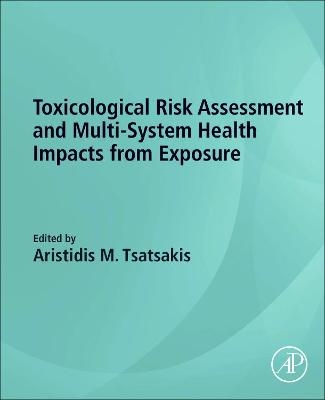
Toxicological Risk Assessment and Multi-System Health Impacts from Exposure
Academic Press Inc (Verlag)
978-0-323-85215-9 (ISBN)
Aristidis Tsatsakis is Director of the Department of Toxicology and Forensic Sciences of the Medical School at the University of Crete and the University Hospital of Heraklion. He has more than 1000 publications, including 700 in ISI journals and is extensively cited. He was EUROTOX President (2014–16) and still an Emeritus Professor for the Federal Institute of Hygiene and Toxicology in Moscow. He is Doctor Honoris Causa of the Mendeleev Moscow University, the Far East Federal University (FEFU), Vladivostok, and the Carol Davila in Bucharest. He is a Foreign Member of the National Academy of Sciences of Russia (FMRAS) and a Fellow of the Academy of Toxicological Sciences (FATS, United States). He is the creator, founder, and chief scientific officer of ToxPlus SA. He developed numerous biomarkers of exposure and of effects for the pesticide and chemical toxicology field, uncovering the mechanistic understanding of the mode of actions, adverse outcome pathways, and clinical affects. He is currently the Editor of Food Chemical Toxicology, Editor-in-Chief of Toxicology Reports, Guest Editor of four special issues in Toxicology Letters, Toxicology and Food and Chemical Toxicology journals, Guest Editor of the RIFM-Food and Chemical Toxicology issue, Associate Editor, and member of the Editorial Boards in several other ISI indexed journals. He has also been recognized as Highly Cited Researcher 2020 in the field of Pharmacology–Toxicology (Publons).
Part 1: Modern tools and concepts in toxicology testing 1. Mixture toxicity evaluation in modern toxicology 2. Alternative methods and their role in modern toxicology 3. The exposome—a new paradigm for nonanimal toxicology and integrated risk assessment 4. In silico toxicology, a robust approach for decision-making in the context of next-generation risk assessment 5. Safety science in the 21st century—a scientific revolution in its making 6. Chemobrain
Part 2: Methods and toxicity models in toxicology 7. "Predictive in silico toxicology." An update on modern approaches and a critical analysis of its strong and weak points 8. Analytical strategies to study the gut microbiome in toxicology 9. Behavioral endpoints in adult and developmental neurotoxicity: the case of organophosphate pesticides 10. Nuclear factor erythroid 2-related factor 2-mediated antioxidant response as an indicator of oxidative stress 11. The potential of complex in vitro models in pharmaceutical toxicology
Part 3: New insights in risk assessment 12. Health-based exposure limits and toxicology in pharmaceutical industry 13. The hormetic dose response: implications for risk assessment 14. Endocrine disruption and human health risk assessment in light of real-life risk simulation 15. Toxicity data as the basis for acute and short-term emergency exposure guidance 16. Renal mitochondria as sentinels for exposures to environmental toxicants and nephrotoxic drugs
Part 4: Clinical biomarkers updates 17. Updates on current biomarkers in toxicology 18. The role of extracellular matrix in allergic contact dermatitis pathogenesis 19. Review of current neurotoxicology issues 20. Modern aspects of immunotoxicology 21. Toxicology of neurodegenerative diseases 22. Toxicogenetics—Pharmacogenetics: genetic variability profiling for xenobiotic response heterogeneity 23. Current and emerging concepts of cardiotoxicity 24. Metabolomics: diagnostic and therapeutic applications in clinical medicine and pharmacology 25. Metabolomics methodology and workflow: challenges and future prospects 26. Telomere length: associations with nutrients and xenobiotics
Part 5: Epidemiology and public health toxicology issues 27. Dismissing the use of P-values and statistical significance testing in scientific research: new methodological perspectives in toxicology and risk assessment 28. Modern approaches for the assessment of human exposure to dietary mycotoxins 29. Tobacco toxicity and regulatory science 30. Dethroning the crown. From the kinetics and dynamics of COVID-19 diagnosis to the promising treatments 31. Toxicology issues related to COVID-19 outbreak 32. Risk assessment for heat stress during work and leisure
Part 6: Pharmaceuticals and nutraceuticals toxicology updates 33. Polyphenols: the hallmark of endothelial dysfunction combatants 34. Effect of diet, pharmaceuticals, and environmental toxicants on gut microbiota imbalance and increased intestinal membrane permeability 35. Hydrogen sulfide: a shifting paradigm 36. Redox biomarkers in toxicology and nutrition: the social link 37. Safety profile of plants and phytoconstituents used in traditional medicine worldwide
Part 7: Toxicology of biomaterials and nanomaterials 38. Epigenetic mechanisms in nanomaterial toxicity 39. Predictive nanotoxicology: from nanotoxicity to nanosafety of select and commonly used nanomaterials 40. The toxicological effects of titanium dioxide nanoparticles on marine microalgae 41. Aquatic nanotoxicology: reference species and omics technologies Part 8: Special topics in toxicology 42. Toxicity of arsenicals in diseases: friend or foe? 43. Toxicity of psychedelic drugs 44. Immunotoxicity of pesticides: current knowledge and perspectives 45. Glyphosate-based herbicides: evidence of immune-endocrine alteration 46. Ciguatera toxins: toxicity and food safety 47. Cannabinoids and psychosis: current challenges of mechanistic toxicology 48. Electronic cigarettes as a harm reduction concept for public health
| Erscheinungsdatum | 16.08.2021 |
|---|---|
| Zusatzinfo | 250 illustrations (50 in full color); Illustrations |
| Verlagsort | Oxford |
| Sprache | englisch |
| Maße | 216 x 276 mm |
| Gewicht | 1830 g |
| Themenwelt | Studium ► 2. Studienabschnitt (Klinik) ► Pharmakologie / Toxikologie |
| ISBN-10 | 0-323-85215-7 / 0323852157 |
| ISBN-13 | 978-0-323-85215-9 / 9780323852159 |
| Zustand | Neuware |
| Haben Sie eine Frage zum Produkt? |
aus dem Bereich


